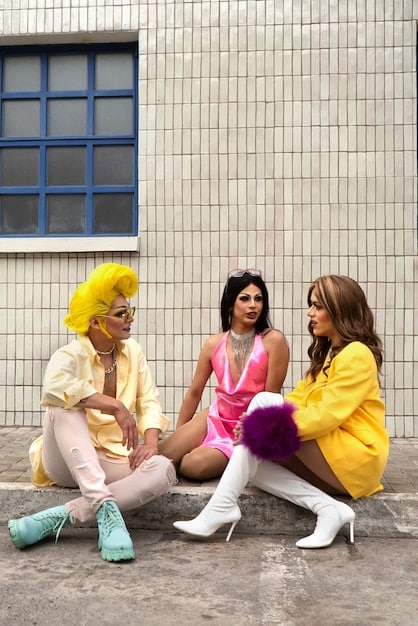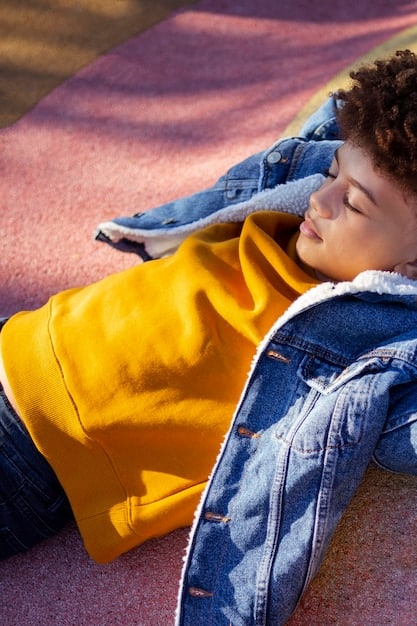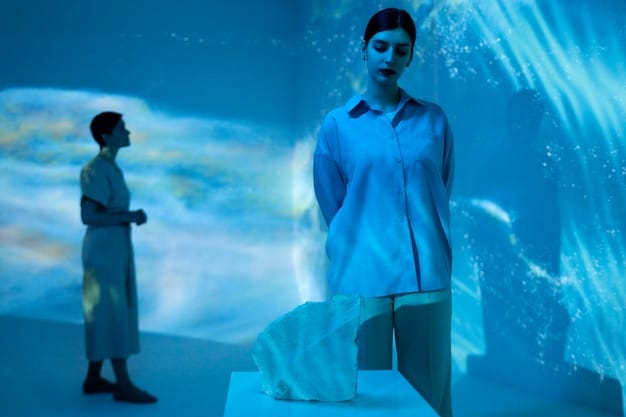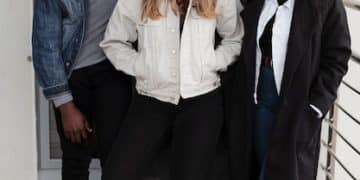Gen Z Style Guide: Decoding Latest Fashion Trends

Anúncios
The Gen Z Style Guide: Decoding the Latest Fashion Trends reveals a dynamic, expressive, and comfort-driven approach to clothing, blending vintage influences with digital aesthetics, prioritizing sustainability, and challenging traditional style norms, reflecting individuality and conscious consumerism.
Welcome to the captivating world of Gen Z fashion, where personal expression reigns supreme and trends emerge with lightning speed. This isn’t just about what’s “in”; it’s about a complete redefinition of style that fuses comfort, authenticity, and a powerful embrace of individuality. In this Gen Z Style Guide: Decoding the Latest Fashion Trends, we’ll peel back the layers to understand the driving forces behind this generation’s unique sartorial choices, from the digital runways of TikTok to the curated racks of thrift stores. Prepare to navigate a landscape where nostalgia meets innovation, and where every outfit tells a story about identity and values.
The Gen Z Fashion Ethos: Beyond Trends
Gen Z’s approach to fashion transcends mere ephemeral trends; it’s a reflection of their core values. This generation, digitally native and globally aware, views clothing as an extension of identity and a platform for self-expression. They aren’t just consumers; they are co-creators of culture, constantly redefining what is fashionable. Their ethos emphasizes authenticity, sustainability, and breaking down traditional gender and style binaries.
Authenticity Over Perfection
Unlike previous generations that often strived for a polished, aspirational look, Gen Z values raw authenticity. This translates into embracing imperfections, mixing high-end with thrifted pieces, and prioritizing comfort above all else. The “effortless” look is meticulously curated to appear spontaneous, rejecting overly manufactured aesthetics.
- Thrifted Treasures: A strong preference for vintage and second-hand items.
- Comfort is King: Athleisure and oversized silhouettes dominate daily wear.
- DIY and Customization: Personalizing clothes to make them uniquely their own.
Gen Z understands that true style comes from within, not from blindly following dictates. This internal compass guides their choices, allowing for a fluid and adaptive wardrobe that evolves with them. This isn’t about being unkempt, but about finding a balance between looking good and feeling genuinely at ease, allowing their true personality to shine through.
Sustainability and Ethics
A significant driver behind Gen Z’s fashion choices is a heightened awareness of environmental and social issues. Fast fashion’s opaque practices and environmental toll are increasingly scrutinized, leading to a shift towards more conscious consumption. This generation actively seeks brands with transparent supply chains, ethical labor practices, and sustainable production methods. They are wary of “greenwashing” and demand genuine commitment to sustainability. This mindful approach extends beyond just purchasing decisions; it also influences clothing care and longevity, promoting repair and repurpose over disposability.
Key Aesthetics Defining Gen Z Style
Gen Z fashion is a vibrant tapestry woven from diverse threads, each representing a unique aesthetic. These aren’t rigid categories but rather fluid inspirations that often overlap and merge, creating truly distinctive looks. From the nostalgic embrace of Y2K to the edgy sophistication of Dark Academia, these aesthetics provide a framework for understanding the visual language of Gen Z.
Y2K Revival: Nostalgia with a Twist
The Y2K aesthetic is perhaps one of the most prominent comebacks, fueled by a collective longing for the early 2000s. However, Gen Z doesn’t simply replicate these trends; they reinterpret them with a modern sensibility. Think low-rise jeans, vibrant velour tracksuits, small shoulder bags, and butterfly clips, but often paired with contemporary streetwear elements or more sustainable fabrics. This revival is less about direct imitation and more about sampling and remixing the past.
Comfort Core & Athleisure: The Everyday Uniform
The pandemic undeniably accelerated the reign of comfort. Athleisure, once confined to gyms, has become a ubiquitous everyday uniform. Oversized hoodies, sweatpants, bike shorts, and chunky sneakers form the foundation of this practical yet stylish aesthetic. It blurs the lines between loungewear and streetwear, proving that comfort doesn’t have to sacrifice style. The focus is on versatility and ease of movement, reflecting Gen Z’s active lifestyles and desire for practical clothing.

E-Girl/E-Boy: Digital Dominance
Born from online communities, the E-Girl and E-Boy aesthetic is characterized by its digital-first origins. This look features exaggerated makeup (winged eyeliner, flushed cheeks), dyed hair, chunky platform shoes, plaid skirts/pants, and often incorporates anime, gaming, or pop-culture references. It’s a playful, often rebellious style that thrives on internet trends and celebrates a unique, performative identity. This aesthetic is a testament to how online personas directly influence real-world fashion choices.
Dark Academia & Cottagecore: Escapism Through Style
On the opposite end of the spectrum, aesthetics like Dark Academia and Cottagecore offer a romanticized escape. Dark Academia evokes a studious, intellectual mood with tweed blazers, cardigans, plaid trousers, and earth tones, inspired by classic literature and vintage university life. Cottagecore, conversely, is a whimsical, pastoral fantasy, featuring prairie dresses, floral prints, puff sleeves, and natural fabrics, idealizing a simpler, rural existence. Both reflect a desire for aestheticized comfort and connection to specific nostalgic ideals, offering a sartorial refuge from modern complexities.
The Influence of Digital Platforms on Gen Z Fashion
Digital platforms are not just spaces where Gen Z showcases their style; they are the very engines that drive and shape fashion trends for this generation. TikTok, Instagram, and Pinterest act as dynamic trend incubators, democratizing fashion, and accelerating its cycles in unprecedented ways. Unlike traditional fashion media, these platforms provide instant feedback loops, allowing trends to go viral overnight and empowering individual creators to become influential tastemakers.
TikTok: The Trend Accelerator
TikTok stands out as the undisputed king of Gen Z fashion trends. Its short-form video format allows for rapid dissemination of styling tips, outfit challenges, and “get ready with me” content. Microtrends emerge and evolve at warp speed, often cycling through popularity in weeks or even days. The algorithm’s ability to expose users to niche content means that diverse aesthetics can gain widespread traction, fostering subcultures around specific styles. This constant flux keeps Gen Z fashion exciting and ever-evolving, driven by user-generated content rather than top-down industry mandates.
Instagram & Pinterest: Visual Mood Boards and Inspiration
While TikTok is about dynamic motion, Instagram and Pinterest remain crucial for visual inspiration and mood boarding. Instagram, despite increasing competition, still serves as a portfolio for fashion influencers and a discovery platform for new brands. Pinterest, with its focus on curated visual collections, is invaluable for planning outfits, discovering specific pieces, and building detailed aesthetic boards. Both platforms allow Gen Z to save, share, and organize their style inspirations, creating personal archives of looks they admire and aspire to replicate or adapt.
These platforms foster a collaborative and interactive fashion environment, where users frequently engage with content, share their own interpretations, and participate in style challenges. The sheer volume of visual content ensures a constant flow of new ideas, democratizing fashion by allowing anyone with a smartphone to become a trendsetter or a style commentator. This continuous feedback loop has made Gen Z fashion incredibly responsive and adaptable, mirroring the fluid nature of digital identity.
Breaking Down Gender Norms and Inclusivity
Gen Z is inherently more fluid in their approach to gender identity, and this fluidity is profoundly expressed through their fashion choices. The traditional binary divisions of menswear and womenswear are increasingly dissolving, giving way to a more inclusive and gender-neutral landscape. This generation champions self-expression over restrictive labels, paving the way for truly individualistic styling.
Deconstructing Gendered Clothing
Gen Z actively challenge the notion that certain garments are exclusively for one gender. They embrace oversized silhouettes, particularly in hoodies, blazers, and trousers, which inherently blur traditional gender lines. Makeup, once largely associated with femininity, is now widely accepted and explored by all genders, from subtle enhancements to bold, creative expressions. This refusal to adhere to conventional norms allows for a greater range of personal expression, where clothing choices are dictated by individual preference rather than societal expectations.
- Oversized Everything: Loose-fitting shirts, jackets, and pants are gender-agnostic.
- Accessory Freedom: Jewelry, bags, and shoes are chosen based on aesthetic appeal, not gender.
- Makeup for All: A growing embrace of cosmetics across gender identities.
This movement towards gender-neutral fashion is not just a trend; it’s a fundamental shift in how this generation constructs identity through appearance. It’s about empowering individuals to wear what makes them feel authentic and comfortable, without fear of judgment or adherence to outdated societal norms.
Body Positivity and Diversity in Representation
Inclusivity extends beyond gender to encompass body diversity and cultural representation. Gen Z demands to see themselves reflected in fashion campaigns and on runways, pushing for authentic representation of all body types, skin tones, and abilities. They gravitate towards brands that celebrate diversity and promote body positivity, rejecting exclusionary standards of beauty. This creates a more welcoming and realistic fashion landscape, where aspiration is tied to personal authenticity rather than unattainable ideals. The collective voice of this generation, amplified by social media, holds brands accountable, forcing the industry to adapt to a more inclusive vision of beauty and style.
The Role of Sustainability and Ethical Consumption
Gen Z’s heightened awareness of global issues positions sustainability and ethical consumption at the forefront of their fashion decisions. This generation inherited a planet grappling with climate change and social inequality, and they are acutely aware of fashion’s significant role in these challenges. Their choices reflect a desire to minimize their environmental footprint and support practices that align with their values, steering away from the excesses of fast fashion.
Moving Beyond Fast Fashion
The fast fashion model, characterized by rapid production cycles, cheap labor, and disposable garments, is increasingly clashing with Gen Z’s values. They are skeptical of brands that prioritize speed and low cost over environmental and social responsibility. While affordability remains a factor, many Gen Z consumers are willing to invest more in pieces that are durable, responsibly made, and have a lower environmental impact. This shift is not a complete abandonment of affordable clothing but a more conscious approach to buying, with research and brand transparency playing key roles. They seek longevity and versatility, gravitating towards items they can wear repeatedly and across different seasons, reducing overall consumption.
Second-Hand and Upcycling Boom
The proliferation of online resale platforms (like Depop, Poshmark, and Vinted) and the enduring appeal of traditional thrift stores have empowered Gen Z to embrace second-hand fashion as a primary mode of consumption. Buying pre-owned items is not only more affordable but significantly reduces the demand for new production, conserving resources and minimizing waste.
- Thrift Store Hauls: A popular content genre showcasing unique finds.
- Depop and Resale Apps: Platforms for buying and selling pre-loved clothes.
- Upcycling and DIY: Transforming old garments into new, unique pieces.
Upcycling and DIY fashion are also gaining massive popularity. Gen Z is actively transforming old garments, giving them new life through customization, dyeing, cutting, and embellishing. This not only promotes creativity and individuality but also extends the lifecycle of clothing items, directly countering textile waste. This hands-on approach contributes to a circular fashion economy, demonstrating that style and sustainability can go hand-in-hand. The embrace of pre-owned and self-modified fashion represents a fundamental shift in consumer behavior, driven by both economic practicality and environmental consciousness.
Future Outlook: What’s Next for Gen Z Style?
Predicting the exact trajectory of Gen Z style is a challenging endeavor, given its dynamic and ever-evolving nature. However, certain overarching themes suggest that future trends will continue to be characterized by authenticity, sustainability, and a fluid approach to identity. As this generation matures, their influence on the fashion industry will only deepen, pushing for greater transparency, innovation, and a fundamental rethinking of how clothes are produced, consumed, and perceived.
Continued Blurring of Lines
The breakdown of traditional style categories will only intensify. Gender fluidity in fashion will become even more commonplace, with brands increasingly releasing gender-neutral collections as standard. The distinctions between casual wear, formal wear, and even costume will continue to blur, allowing for greater creative expression. This means we’ll see more versatile pieces that can be dressed up or down, adapted for various occasions, and styled to reflect individual moods rather than strict dress codes. The emphasis will remain on personal comfort and self-expression, fostering a truly personalized approach to dressing.

Technological Integration and Digital Fashion
The metaverse and digital fashion are nascent but rapidly growing frontiers that will profoundly impact how Gen Z interacts with style. Digital garments, NFTs, and virtual try-on experiences are not just novelties; they represent a new dimension for self-expression and consumption. As virtual worlds become more sophisticated, digital avatars will require wardrobes, creating a parallel fashion economy. This also opens up avenues for experimentation without physical waste, potentially influencing real-world design and trends. Furthermore, advancements in sustainable textile technology and ethical manufacturing processes will become increasingly attractive to a generation that values innovation paired with responsibility.
The future of Gen Z style is unlikely to be dictated by a single, monolithic trend. Instead, it will be a fragmented yet interconnected mosaic of individual expressions, shaped by technological advancements, environmental consciousness, and a ceaseless pursuit of authentic self-representation. Brands that can genuinely align with these values—offering transparency, inclusivity, and opportunities for creative personalization—will be the ones that succeed in capturing the imagination and loyalty of this influential demographic. The key will be adaptability, as Gen Z’s style journey is one of continuous evolution and redefinition.
Navigating Your Own Gen Z Style Journey
Embracing the Gen Z style ethos isn’t about mimicking every fleeting trend; it’s about understanding the underlying principles that drive this generation’s fashion choices. It’s an invitation to explore your own identity through clothing, prioritizing comfort, authenticity, and responsible consumption. This journey is intensely personal, reflecting individual values and creative instincts.
Cultivating Personal Expression
The core of Gen Z style lies in radical self-expression. This means moving beyond external validation and dressing in a way that genuinely resonates with who you are. Experiment with different aesthetics, colors, and silhouettes. Mix and match pieces that might traditionally seem disparate. The beauty of this approach is that there are no strict rules, only guidelines for inspiration. Your wardrobe should be a reflection of your personality, your mood, and your values. Don’t be afraid to combine vintage finds with modern basics, or high-end items with thrift store gems. The goal is to create a look that feels uniquely “you,” rather than conforming to a prescribed mold.
Conscious Consumption and Practical Application
Adopting a more sustainable approach is a practical step towards aligning with Gen Z values. Start by assessing your current wardrobe and considering what you truly need. Invest in versatile, quality pieces that can be dressed up or down. Explore second-hand shopping, whether online or in physical stores, to find unique items and reduce your environmental footprint. Consider learning basic mending or upcycling skills to extend the life of your clothes. When purchasing new items, research brands to understand their ethical and sustainable practices. This conscious approach isn’t just good for the planet; it also encourages a more mindful and deliberate relationship with your clothing, fostering a deeper appreciation for each item you own. By integrating these principles into your daily style, you’re not just following a trend; you’re participating in a broader cultural shift towards more meaningful and sustainable ways of living.
| Key Trend | Brief Description |
|---|---|
| ✨ Authentic Expression | Prioritizing individuality, comfort, and unique mixes over rigid fashion rules. |
| ♻️ Sustainable Choices | Strong preference for second-hand, upcycled, and ethically produced fashion. |
| 📱 Digital Influence | TikTok and other platforms are key drivers of fast-evolving microtrends. |
| 👕 Gender Neutrality | Breakdown of traditional gendered clothing, favoring inclusive designs. |
Frequently Asked Questions About Gen Z Fashion
Gen Z’s fashion philosophy is centered on authenticity, individuality, and comfort. They prioritize expressing their unique identity over blindly following trends. This generation often blends vintage and thrifted items with contemporary streetwear, emphasizing personal style, sustainability, and breaking traditional gender norms. Their choices also reflect a strong awareness of social and environmental issues, moving away from fast fashion.
Sustainability is highly important to Gen Z. They are increasingly concerned about the environmental and social impact of the fashion industry. This leads them to favor second-hand clothing, upcycling, and supporting brands with transparent, ethical, and sustainable practices. They are known for questioning fast fashion and seeking durable, long-lasting pieces to reduce waste and promote conscious consumption.
TikTok is arguably the most influential platform for Gen Z fashion, driving rapid trend cycles and fostering micro-communities around aesthetics. Instagram and Pinterest also play significant roles as visual mood boards for inspiration and brand discovery. These platforms enable individuals to become trendsetters and allow for the quick dissemination and evolution of styles, democratizing the fashion landscape for this generation.
Popular Gen Z aesthetics include the Y2K revival, characterized by early 2000s nostalgic elements like low-rise jeans and bright colors. Comfort core and athleisure dominate daily wear with oversized pieces and sweats. The E-Girl/E-Boy aesthetic integrates digital and pop culture influences. Dark Academia offers a scholarly, vintage look, while Cottagecore embraces pastoral, whimsical styles. These aesthetics blend and evolve, showcasing Gen Z’s diverse tastes.
Gen Z is actively breaking down traditional gender norms in fashion by embracing gender-neutral clothing, such as oversized silhouettes and unisex designs. They often prioritize personal comfort and expression over established masculine or feminine styles. This includes a more widespread acceptance of makeup and accessories for all genders, fostering a fluid and inclusive approach to self-presentation where clothing is chosen based on individual preference, not stereotypes.
Conclusion: The Evolving Canvas of Gen Z Style
The Gen Z style guide is not a rigid set of rules but a dynamic, ever-evolving canvas that reflects a generation deeply connected to expression, purpose, and impact. Their fashion choices are a compelling narrative of self-authenticity, a conscious rejection of norms, and a powerful embrace of sustainability. From the digital trends that ignite their inspiration to the deeply personal comfort that defines their daily wear, Gen Z continues to reshape the very definition of what it means to be stylish in the 21st century. Their influence extends far beyond mere clothing, signaling a broader cultural shift towards values-driven consumption and the celebration of individuality in its purest form.





